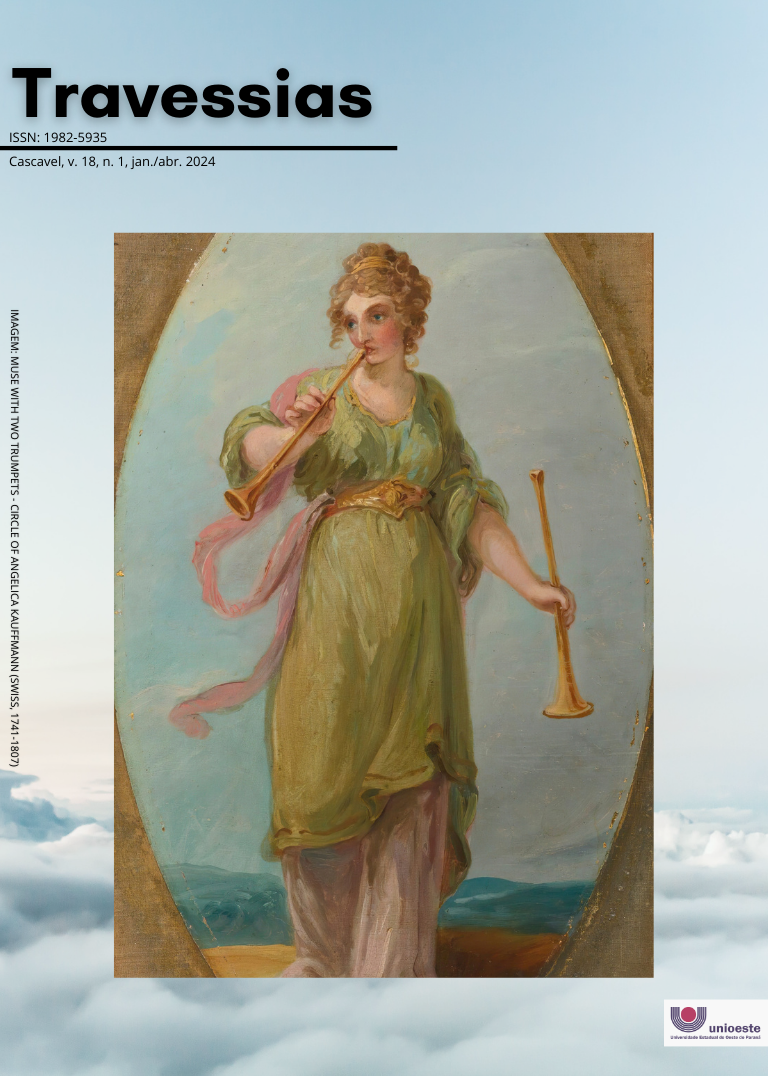Como respirar debaixo d’água
o suicídio e o ajustamento criativo em Virginia Woolf
DOI:
https://doi.org/10.48075/rt.v18i1.31892Palavras-chave:
Suicídio, Virginia Woolf, Representação, Ajustamento criativoResumo
O presente trabalho pretende analisar possíveis relações biográficas de Virginia Woolf no romance Mrs. Dalloway, de 1925. Na vasta bibliografia literária da autora, apenas em Mrs. Dalloway aparece uma personagem suicida, Septimus Warren-Smith, o que nos leva a refletir sobre as escolhas de Woolf na construção da personagem e em sua apresentação na trama. Segundo o teórico literário, Maurice Blanchot, a literatura é estritamente um espaço de morte, portanto, considerando esse aspecto, a personagem Septimus Warren-Smith poderia apresentar indícios de um evento premonitório: o suicídio da autora alguns anos depois. Virginia Woolf demonstra, por meio de alguns registros, a importância da escrita para sua vida ao utilizar do espaço literário como um exercício catártico de sua relação com o mundo. A intenção do artigo consiste em identificar uma possibilidade de sobrevida da autora a partir da morte de Septimus Warrren-Smith no romance. Para isso, recorreu-se ao conceito de ajustamento criativo da Gestalt-Terapia, através dos estudos de Perls (1977); Hefferline (1997); Goodman (1997), com objetivo de alucidar a relação da autora com seu fazer artístico e sua suposta sobrevida, como também, aos ensaios de Marice Blanchot (1987; 2011) acerca da atividade literária e sua correspondência com a morte. Além disso, com a intenção de possibilitar uma visão abrangente dos fatos envolvidos – estéticos e biográficos – foram necessários somar às ferramentas metodológicas da Teoria da Literatura, como James Wood (2012), e dos Estudos Culturais, como Foucault (2001), aspectos da psicanálise asseverados por Freud (2010) e estudos sobre atributos biográficos elaborados por Bourdieu (2006).
Downloads
Referências
AGUIAR, L. Gestalt-terapia com Crianças: teoria e prática. Campinas: Livro Pleno, 2005.
BACHELARD, G. A água e os sonhos: Ensaio sobre a imaginação da matéria. Tradução de Antonio de Pádua Danesi. São Paulo: Martins Fontes, 2002.
BLANCHOT, M. A conversa infinita. Tradução de Aurélio Guerra Neto. São Paulo: Escuta, 1987.
BLANCHOT, M. O Espaço literário. Tradução de Álvaro Cabral. Rio de Janeiro: Rocco, 2011.
BLANCHOT, M. O “Literatura e o direito à morte”. In: BLANCHOT, M. A parte do fogo. Tradução de Ana Maria Scherer. Rio de Janeiro: Rocco, 2011.
BOURDIEU, P. A ilusão biográfica. In: AMADO, J.; FERREIRA, M. M. Usos e abusos da história oral. 8. ed. Rio de Janeiro: Editora FGV, 2006. p. 183-191.
DELEUZE, G. O ato de criação. Folha de São Paulo. Transcrição de conferência realizada em 1987, 1999, p. 342.
FOUCAULT, M. O que é um autor? In: MOTTA, M. B. (org.). Estética: literatura e pintura, música e cinema. Tradução de Inês Autran Dourado Barbosa. Rio de Janeiro: Forense Universitária, 2001. p. 264-98.
FREUD, S. Nossa atitude perante a morte. In: FREUD, S. Obras completas – Volume 12: Introdução ao narcisismo, ensaios de metapsicologia e outros textos. Tradução de Paulo César de Souza. São Paulo: Companhia das Letras, 2010. p. 175-225.
GAMA-KHALIL, M. M. A literatura e o gesto do suicídio. In: PRATA, V.; MIANEZ, N. (org). Filosofia do Suicídio. Vitória da Conquista: Labedisco, 2016.
LIMA, R. A. de. Sergio Blanco (1971 - 2015): o suicídio como ato poético. Revista Criação & Crítica, v. 23, 2019, p. 135-160. Disponível em: https://doi.org/10.11606/issn.1984-1124.v0i23p135-160. Acesso em: 28 mar. 2023.
MAGALHÃES, M. M. A Infidelidade Conjugal e seus Mitos: uma leitura gestáltica. Revista IGT na Rede, v. 6, n. 10, p. 58-90, 2009. Disponível em: http://www.igt.psc.br/ojs/. Acesso em: 28 mar. 2023.
MARKENDORF, M. A invenção da fama em Sylvia Planth. Tese (Doutorado em Literatura) - Universidade Federal de Santa Catarina, Centro de Comunicação e Expressão. Programa de Pós-Graduação em Literatura. Florianópolis, 2009. Disponível em: http://repositorio.ufsc.br/xmlui/handle/123456789/92273. Acesso em: 06 set. 2022.
MISRAHI, A. Adiós mundo cruel. Barcelona: Editorial Océano, 2003.
PAULS, A. Prefácio para Mrs. Dalloway de Virginia Woolf. 1. ed. São Paulo: Penguin Classics Companhia das Letras, 2017. p. 7-19.
PERLS, F.; HEFFERLINE, R.; GOODMAN, P. Gestalt-Terapia. 2. ed. São Paulo: Summus, 1997.
PERLS, F. Gestalt-Terapia explicada. 10. ed. São Paulo: Summus, 1977.
SCHOLLHAMMER, Karl Erik. Ficção brasileira contemporânea. Rio de Janeiro: Civilização Brasileira, 2009.
SOLOMON, A. Um crime da solidão: Reflexões sobre o suicídio. 1. ed. São Paulo: Companhia das Letras, 2018.
WOOD, J. Como funciona a ficção. São Paulo: Cosac Naify, 2012.
WOOLF, V. Mrs. Dalloway. Tradução de Claudio Alves Marcondes. São Paulo: Penguin Classics Companhia das Letras, 2017.
Downloads
Publicado
Como Citar
Edição
Seção
Licença
Copyright (c) 2024 Autores mantêm os direitos autorais e concedem à revista o direito de primeira publicação, com o trabalho simultaneamente licenciado sob CC-BY-NC-SA 4.0 que permite o compartilhamento do trabalho com indicação da autoria e publicação inicial nesta revista

Este trabalho está licenciado sob uma licença Creative Commons Attribution-NonCommercial-ShareAlike 4.0 International License.
Aviso de Direito Autoral Creative Commons
Política para Periódicos de Acesso Livre
Autores que publicam nesta revista concordam com os seguintes termos:
1. Autores mantêm os direitos autorais e concedem à revista o direito de primeira publicação, com o trabalho simultaneamente licenciado sob a Licença Creative Commons Attribution que permite o compartilhamento do trabalho com reconhecimento da autoria e publicação inicial nesta revista.
2. Autores têm autorização para assumir contratos adicionais separadamente, para distribuição não-exclusiva da versão do trabalho publicada nesta revista (ex.: publicar em repositório institucional ou como capítulo de livro), com reconhecimento de autoria e publicação inicial nesta revista.
3. Autores têm permissão e são estimulados a publicar e distribuir seu trabalho online (ex.: em repositórios institucionais ou na sua página pessoal) a qualquer ponto antes ou durante o processo editorial, já que isso pode gerar alterações produtivas, bem como aumentar o impacto e a citação do trabalho publicado (Veja O Efeito do Acesso Livre).
Licença Creative Commons
Esta obra está licenciada com uma Licença Creative Commons Atribuição-NãoComercial-CompartilhaIgual 4.0 Internacional, o que permite compartilhar, copiar, distribuir, exibir, reproduzir, a totalidade ou partes desde que não tenha objetivo comercial e sejam citados os autores e a fonte.



